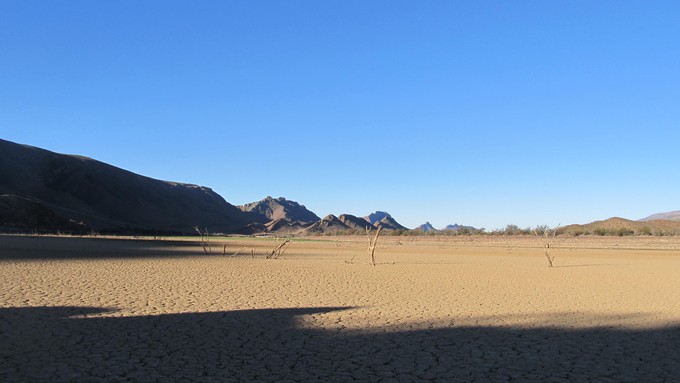
Fish skeletons litter the dry ground of the Gamkapoort Dam. Photo: Jonny Wilkinson
8 September 2016
If the rain doesn’t come soon to fill the Gamkapoort Dam near Calitzdorp, jobs on the surrounding farms may be lost.
Since early 2016, for the first time in 24 years, the dam on the southern edge of the Great Karoo has been mostly empty, according to the honorary bailiff, Fox Ledeboer. The dam irrigates 2,000 hectares of farmland around Calitzdorp.
The light summer rainfall did not replenish the water that farmers used up, and by early May all that remained were a few dirty puddles and a fish graveyard. A couple of weeks ago some rainwater came in. If the dam were to be opened, this water might just make it to Calitzdorp before running out again, says Ledeboer.
About 70 farms depend on the dam for 95% of their water supply, mostly during the summer months, according to Ernie Fourie, a local farmer and chairperson of the Gamka Rivier Irrigation Board, which represents 44 registered farm owners reliant on the dam.
Because this region of the Karoo typically gets most of its rainfall in summer, the dam remained empty throughout winter. It is now heading into the 2016-17 growing season without enough water for the farmland it irrigates.
If the dam remains empty or water levels are too low for it to be opened, this will put strain on small local farms to grow enough produce and pay their workforce. The bigger farms employ up to 50 workers, usually a combination of permanent and seasonal workers.
The farms mostly grow maize, lucerne and vegetables including carrots, onions, butternut and cauliflower.
Only the barks of sentinel baboons break the silence at the dam. In better times, when there would be more signs of life, the dam could hold 42 million cubic metres of water, giving the farms a two-year supply, says Ledeboer, who has maintained the dam since 1992.
Fourie says there is not much that farmers can do if the dam remains dry. “Like in other areas of the country when it is dry, [farmers] can do nothing. They can’t plant any crops because they can’t irrigate them,” he says. “We’re hopeful that it will rain but if this doesn’t happen, then it will be a big problem.” Asked about any contingency plan, Fourie said there is none. “If it’s not raining, there’s no water.”

Johan Arnoldus, a farmer known in the community as Gols, uses water from the dam for crops which he sells at markets in Oudtshoorn, George and Port Elizabeth. If the dam remains low, Arnoldus will have to rely on the little rainwater that flows from the mountains - not enough, he says. His main worry is not being able to pay his eight permanent workers or take on seasonal workers.
Jan van Staden, Senior Manager of Water Resources at Breede-Gouritz Catchment Management Agency, an operational arm of the Department of Water and Sanitation, that manages water resources across large parts of the Karoo, says that “the latest weather predictions are confirming possible rains in September”.
Van Staden told GroundUp on 1 September that the dam was 7% full. “If the dam is not filling up there will be water restrictions for the irrigators depending on the level of the dam.”
Ledeboer says that the 7% figure doesn’t reflect the actual water level as most of that is silt. Fourie says that the dam needs to be about 15% full in order for it to be opened.
Why the dam has dried up is not clear. Ledeboer believes it was the recent El Niño, a recurring climate event that results in drier (and in some areas, wetter) than normal conditions across the world. The 2014-16 El Niño, which dissipated in May, was among the strongest on record, according to the National Oceanic and Atmospheric Administration in the USA.
However, Dr Peter Johnston, a climate scientist at the University of Cape Town, told GroundUp that the impacts of an El Niño drought would be most seriously felt in the eastern and north-eastern parts of the country and Zimbabwe and Mozambique – regions which would otherwise experience summer rainfall. There is no consensus of scientific evidence that south-western parts of the Cape would have a drier than normal winter during an El Niño, Johnston says.
The Gamkapoort Dam is situated right at the edge of these two zones, making it unclear if El Niño is a cause of the lack of water. Local climate variation factors may have had more of an effect. Nevertheless, climate factors are more likely to blame rather than functional integrity of the dam, which Ledeboer says is in intact. There are also no signs that rivers would not flow properly into the dam, given enough rainfall.
Should summer not bring enough rain for the whole growing season, Calitzdorp farmers dependent on the Gamkapoort Dam will struggle to make enough income and pay their workforce. And with agriculture being a big part of the Karoo economy, alternative forms of employment for farm workers may be hard to find.